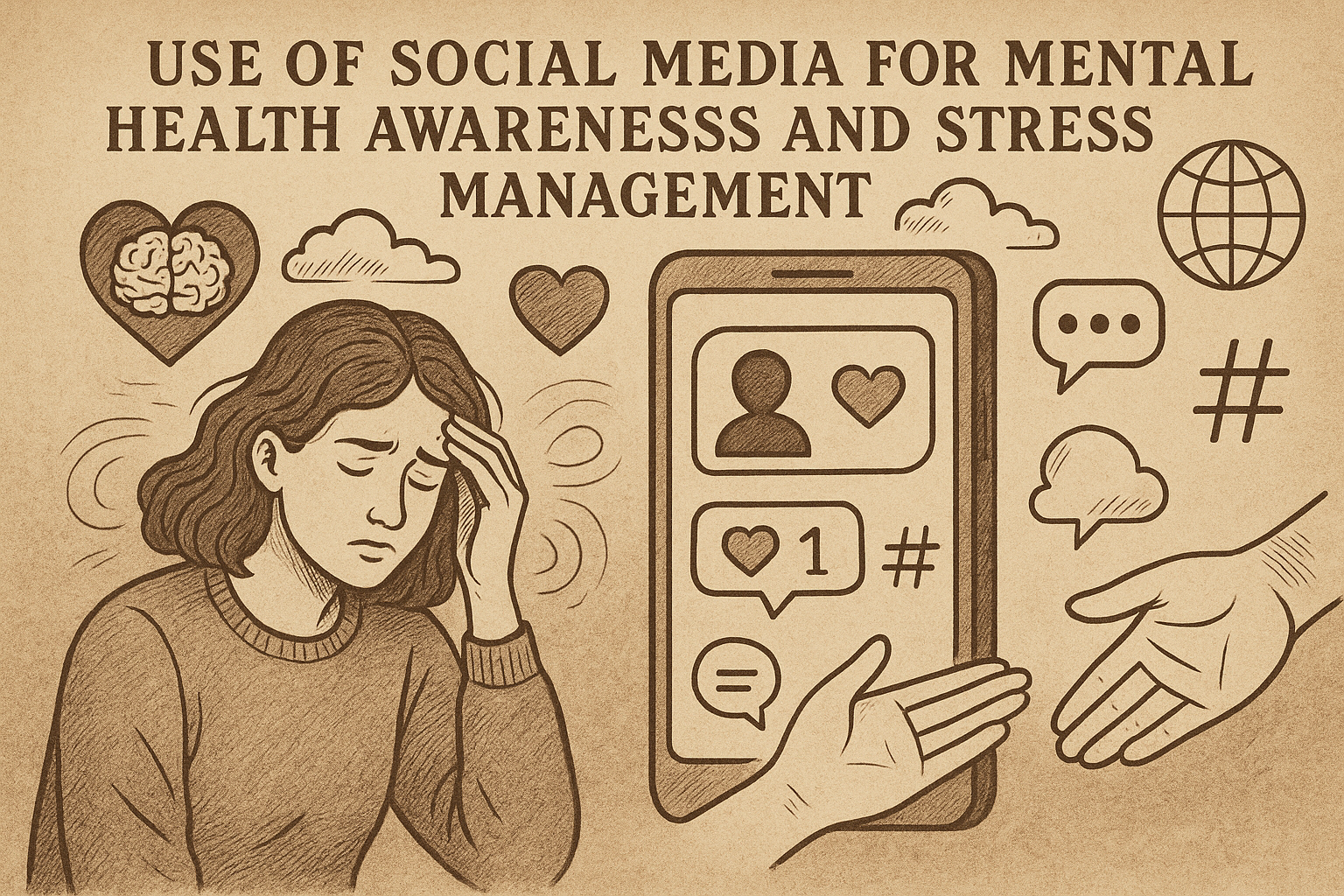Introduction
Social media has taken the world by storm. What began as a way to stay in touch with friends and family has become a powerful platform for branding, advertising, and spreading awareness about important issues. Today, platforms like TikTok, Instagram, and X (formerly Twitter) are not just spaces for entertainment but also tools for advocacy. From marketing businesses to starting social movements, social media is shaping conversations that affect millions of people worldwide.
One of the most significant areas where social media has made an impact is mental health awareness. In a world where anxiety, depression, and stress are increasingly common, digital platforms provide a space to break the silence and fight stigma. At the same time, social media can become a double-edged sword—while it can help people find support and share resources, it can also increase stress levels and expose individuals to cyberbullying. The key lies in using these platforms mindfully.
This article explores how social media can raise awareness about mental health, provide stress management strategies, promote empathy, and create supportive communities. It also highlights the importance of using digital tools responsibly to ensure they contribute positively to mental well-being.
Using Social Media to Raise Awareness of Mental Health Issues
Mental health struggles are often invisible, and many people feel ashamed to talk about them. Social media helps break down this silence by giving individuals and organizations a global platform to share stories, campaigns, and resources. For example, global awareness campaigns like #MentalHealthAwarenessWeek, #WorldMentalHealthDay, and #EndTheStigma trend every year, drawing attention to depression, anxiety, PTSD, and other conditions that affect millions.
Hashtags function as digital bridges, connecting individuals who may feel isolated. Someone in Jakarta can read the story of a student in New York who battled exam stress, while a teacher in London can learn about mindfulness techniques shared by a wellness coach in Sydney. These connections reduce feelings of loneliness and normalize the conversation around seeking professional help.
Moreover, social media allows mental health professionals, NGOs, and advocates to share valuable resources—whether it is a helpline number, therapy options, or stress-relief practices. Instead of suffering in silence, people scrolling through Instagram or TikTok might stumble upon content that reassures them that they are not alone.
By amplifying real voices and campaigns, social media becomes a tool of collective healing and advocacy, challenging stigma and encouraging more open conversations about mental health.
Stress Management in the Age of Social Media
Stress is a universal experience, but the digital era has both worsened and relieved it. On one hand, constant notifications, comparison culture, and information overload can heighten anxiety. On the other hand, social media offers resources that can help people manage their stress more effectively.
Platforms like YouTube and TikTok are filled with short guided meditation clips, ASMR videos, and breathing exercises that users can access anytime, anywhere. Instagram pages dedicated to journaling, gratitude practices, and wellness routines inspire users to integrate stress-relieving habits into their daily lives. Even memes—though lighthearted—can serve as coping mechanisms by allowing people to laugh at their struggles and find comfort in shared experiences.
The key is balance. Social media should not become a constant escape that prevents people from facing real-life challenges. Instead, it should serve as a tool for reflection, relaxation, and learning. Following accounts that promote mindfulness, joining groups that focus on stress management, and setting healthy screen-time limits can make digital engagement more beneficial.
When used intentionally, social media can be transformed from a source of anxiety into a practical toolkit for stress relief.
Promoting an End to Bullying Through Social Media
Bullying has long been a painful reality, but with the rise of the internet, it has evolved into cyberbullying—an issue that affects children, teens, and even adults. Social media, ironically, can be both the cause and the cure. While online harassment can cause immense harm, platforms also offer tools to counteract it.
Anti-bullying campaigns like #BeKind, #StopBullying, and #ChooseKindness have gained momentum worldwide. Celebrities, influencers, and everyday users share stories about resilience, spreading messages that emphasize empathy over cruelty. By openly discussing cyberbullying, social media helps reduce its power and encourages people to speak up instead of suffering in silence.
Equally important is the role of digital communities. Online support groups allow victims of bullying to connect, share experiences, and receive emotional validation. By building safe spaces, social media users create networks where compassion replaces hostility.
In this sense, social media becomes more than entertainment; it transforms into a shield against bullying and a platform for empathy, awareness, and collective action.
Encouraging a Culture of Empathy and Respect
One of the greatest benefits of social media is its ability to foster empathy. Behind every profile picture is a human being with feelings, struggles, and dreams. When people share personal stories about anxiety, depression, or loss, it creates opportunities for others to listen, learn, and respond with compassion.
Promoting respect online means resisting the urge to judge based on appearances or number of likes. It requires understanding that social media represents only fragments of reality, not the whole picture. Users can contribute by leaving supportive comments, sharing uplifting content, and avoiding toxic comparisons.
This culture of empathy not only benefits individuals struggling with mental health but also strengthens society as a whole. A supportive digital environment encourages people to seek help when needed, to express themselves authentically, and to feel less alone in their journey.
Building Online Communities for Mental Health Support
Community is central to human well-being, and social media makes it possible to form global support systems. Online groups on Facebook, subreddits dedicated to mental health, or Instagram communities centered on positivity bring together people from diverse backgrounds who share common struggles.
These communities provide safe spaces to vent frustrations, seek advice, or simply connect with others who understand. For many people, this virtual support network supplements or even replaces real-world interactions, especially when access to mental health services is limited.
By contributing positively to these communities—whether by sharing coping strategies, encouraging others, or simply listening—users reinforce the idea that no one has to go through their struggles alone. Social media thus becomes a digital sanctuary for healing, encouragement, and solidarity.
Using Technology to Manage Stress
Beyond communities, technology itself offers powerful tools for stress management. Mobile apps like Headspace, Calm, and Insight Timer provide guided meditations, breathing exercises, and sleep stories. Journaling apps encourage reflection, while fitness trackers remind users to move, stretch, and rest.
Integrating these tools with social media can be transformative. Sharing personal wellness goals, progress updates, or favorite relaxation practices inspires others to adopt similar routines. By merging personal responsibility with public accountability, people create healthier habits for themselves while motivating their digital circles.
Technology is not a cure-all, but when combined with mindful social media use, it can become a reliable partner in maintaining emotional balance.
Conclusion
Social media is not just a place for entertainment—it is a mirror of society, a stage for advocacy, and a tool for collective healing. When used intentionally, it can raise awareness about mental health, provide stress management strategies, fight bullying, and encourage empathy. But it is crucial to remember that social media is not reality. Likes, comments, and followers do not determine one’s worth.
The challenge lies in harnessing the positive potential of social media while avoiding its pitfalls. By sharing stories, building supportive communities, and encouraging kindness, we can transform digital platforms into spaces that nurture mental well-being instead of draining it.
In the end, social media is what we make of it. If we choose empathy, creativity, and respect, then the digital world can become a healthier, safer place for all.



Leave a Reply